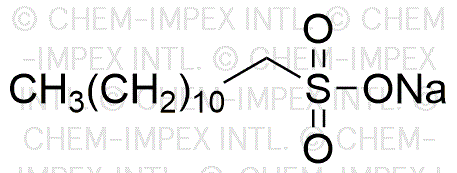Sodium 1-dodecanesulfonate is widely utilized in research focused on:
- Surfactant Applications: This compound serves as an effective surfactant in various cleaning products, enhancing the ability to remove dirt and grease. Its long-chain structure provides excellent foaming properties, making it ideal for household and industrial cleaners.
- Emulsification: In the food industry, it acts as an emulsifier, helping to stabilize mixtures of oil and water. This is particularly useful in products like sauces and dressings, ensuring a consistent texture and flavor.
- Cosmetic Formulations: Sodium 1-dodecanesulfonate is commonly found in personal care products, such as shampoos and lotions, where it improves texture and enhances the product's ability to spread evenly on the skin or hair.
- Biotechnology: In laboratory settings, it is used as a dispersing agent in the preparation of biological samples, aiding in the stabilization of cell membranes and improving the efficiency of various assays.
- Textile Industry: The compound is utilized in textile processing as a wetting agent, promoting better dye uptake and improving the overall quality of dyed fabrics.
General Information
Properties
Safety and Regulations
Applications
Sodium 1-dodecanesulfonate is widely utilized in research focused on:
- Surfactant Applications: This compound serves as an effective surfactant in various cleaning products, enhancing the ability to remove dirt and grease. Its long-chain structure provides excellent foaming properties, making it ideal for household and industrial cleaners.
- Emulsification: In the food industry, it acts as an emulsifier, helping to stabilize mixtures of oil and water. This is particularly useful in products like sauces and dressings, ensuring a consistent texture and flavor.
- Cosmetic Formulations: Sodium 1-dodecanesulfonate is commonly found in personal care products, such as shampoos and lotions, where it improves texture and enhances the product's ability to spread evenly on the skin or hair.
- Biotechnology: In laboratory settings, it is used as a dispersing agent in the preparation of biological samples, aiding in the stabilization of cell membranes and improving the efficiency of various assays.
- Textile Industry: The compound is utilized in textile processing as a wetting agent, promoting better dye uptake and improving the overall quality of dyed fabrics.
Documents
Safety Data Sheets (SDS)
The SDS provides comprehensive safety information on handling, storage, and disposal of the product.
Product Specification (PS)
The PS provides a comprehensive breakdown of the product’s properties, including chemical composition, physical state, purity, and storage requirements. It also details acceptable quality ranges and the product's intended applications.
Certificates of Analysis (COA)
Search for Certificates of Analysis (COA) by entering the products Lot Number. Lot and Batch Numbers can be found on a product’s label following the words ‘Lot’ or ‘Batch’.
*Catalog Number
*Lot Number
Certificates Of Origin (COO)
This COO confirms the country where the product was manufactured, and also details the materials and components used in it and whether it is derived from natural, synthetic, or other specific sources. This certificate may be required for customs, trade, and regulatory compliance.
*Catalog Number
*Lot Number
Safety Data Sheets (SDS)
The SDS provides comprehensive safety information on handling, storage, and disposal of the product.
DownloadProduct Specification (PS)
The PS provides a comprehensive breakdown of the product’s properties, including chemical composition, physical state, purity, and storage requirements. It also details acceptable quality ranges and the product's intended applications.
DownloadCertificates of Analysis (COA)
Search for Certificates of Analysis (COA) by entering the products Lot Number. Lot and Batch Numbers can be found on a product’s label following the words ‘Lot’ or ‘Batch’.
*Catalog Number
*Lot Number
Certificates Of Origin (COO)
This COO confirms the country where the product was manufactured, and also details the materials and components used in it and whether it is derived from natural, synthetic, or other specific sources. This certificate may be required for customs, trade, and regulatory compliance.

